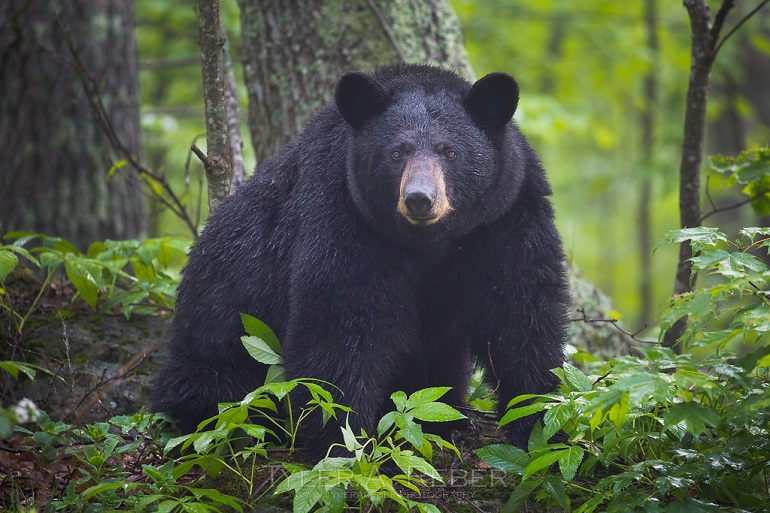When Theodore Roosevelt chose not to shoot that black bear back in 1902, he started a craze that continues today. That black bear he saved became the father of all teddy bears, but there’s no evolutionary link between the two!
Let’s leave the teddy bears where they belong (in bed) and focus on the iconic black bears instead.
Black bears are the smallest bear species in North America but one of the most widespread. They often make their presence known by stealing human food, showing a particular fondness for junk food.
This isn’t their natural diet, but as omnivorous scavengers, they’ll take what they can get.
There’s a lot more to the black bear than its love of pizza, however, and if you bear with me until the end of this article, you’ll find it has some fascinating traits that few other bear species can replicate.
Introducing the American Black Bear
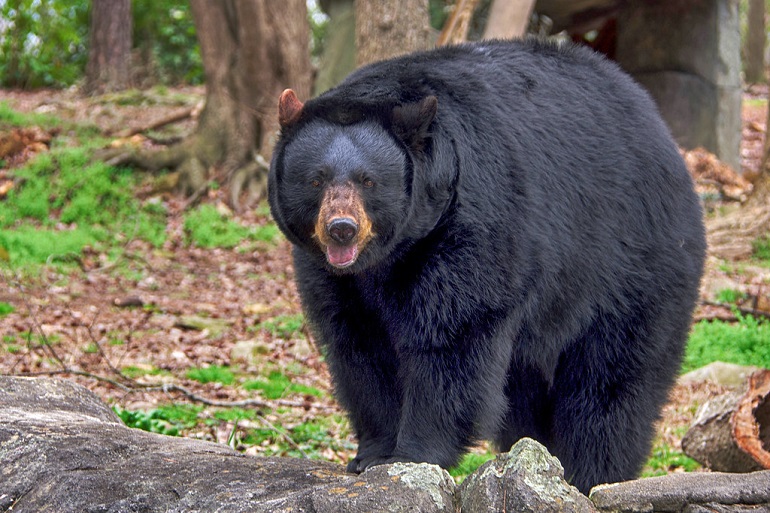
American black bears look very similar to a brown bear, except that they’re smaller and usually wear darker coats.
Despite their similarities, the two species aren’t closely related, having split from a common ancestor over five million years ago.
In fact, black bears have more in common with Asian bears than either the grizzly or the polar bear, which is weird as some black bears are actually white!
The Taxonomy and Evolution of the Black Bear
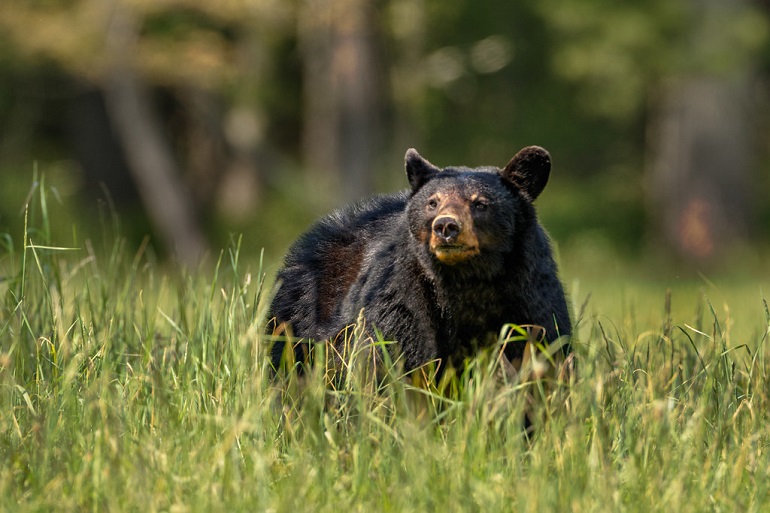
The first bears to appear on Earth looked and behaved more like dogs than the bears we know today.
The Dawn bear, Ursavus elmensis, is thought to provide an evolutionary link between modern-day bears and their carnivorous ancestors and also explains why the Asiatic and American black bears are so similar, despite them living so far apart.
Lower sea levels provided land bridges like the Bering Strait, which enabled bears to travel to new continents, and it’s believed the American black bear’s ancestor arrived in North America nearly five million years ago.
This primitive bear, known as Ursus abstrusus, was much smaller than today’s bears and looked more like raccoons than bears.
Hybrids
The American and Asian black bears are so closely related that they can mate and produce viable hybrid offspring, although the chances of their cubs surviving into adulthood are relatively small.
Charles Darwin’s observations led him to believe that, although individuals from the two species may mate, the chances of them conceiving were small.
Nevertheless, hybrid bears are thought to exist, including one that, due to its size, was believed to be a cross between a grizzly bear and a North American black bear.
Unfortunately, the DNA tests proved inconclusive, so we’ll never know if it really was a hybrid or just a particularly large black bear.
Black Bear Subspecies
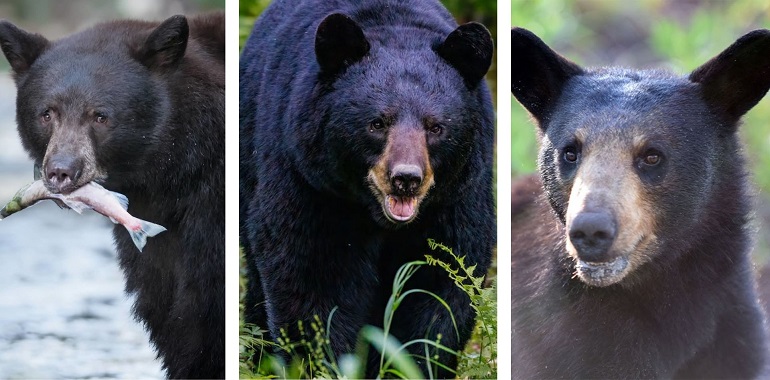
Not all black bears look the same, nor do they share the same DNA, which has led scientists to officially recognize 16 different subspecies of black bears, ranging from the Kermode bear of British Colombia to the Mexican black bear.
The 16 subspecies of black bear are:
- American Black Bear
- California Black Bear
- Cinnamon Bear
- Dall Black Bear
- Florida Black Bear
- Glacier Bear
- Haida Gwaii black bear
- Kenai Black Bear
- Kermode Bear
- Louisiana Black Bear
- Mexican Black Bear
- Newfoundland Black Bear
- New Mexico Black Bear
- Olympic Black Bear
- Vancouver Island Black Bear
- West Mexican Black Bear (Ursus americanus machetes)
Scientific Classification
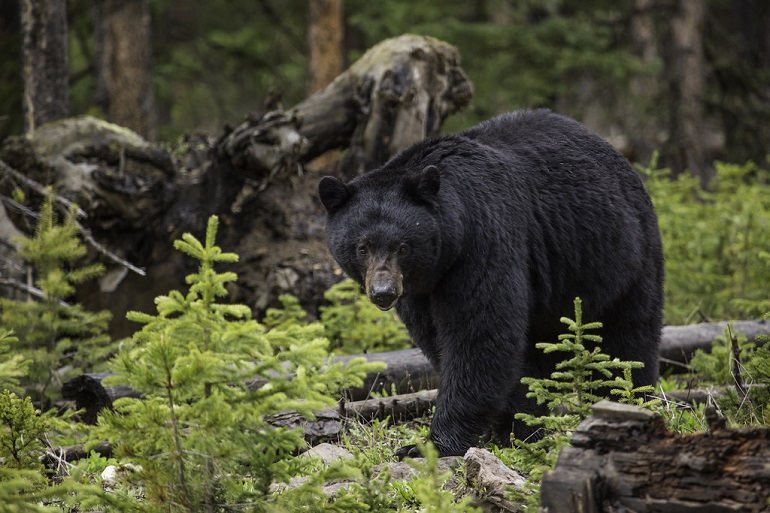
The black bear goes by the scientific name Ursus americanus, which means it belongs to the family Ursidae. This family contains eight bear species, including both the polar bears and the grizzly.
They are all dog-like carnivores, so belong to the order Carnivora, even though some, like the black bear, prefer a more varied diet that includes berries, leaves, pizza, and chips!
The only bears that don’t belong to this family are those that aren’t really bears at all, like the teddy bear and the koala.
The Population and Distribution of Black Bears
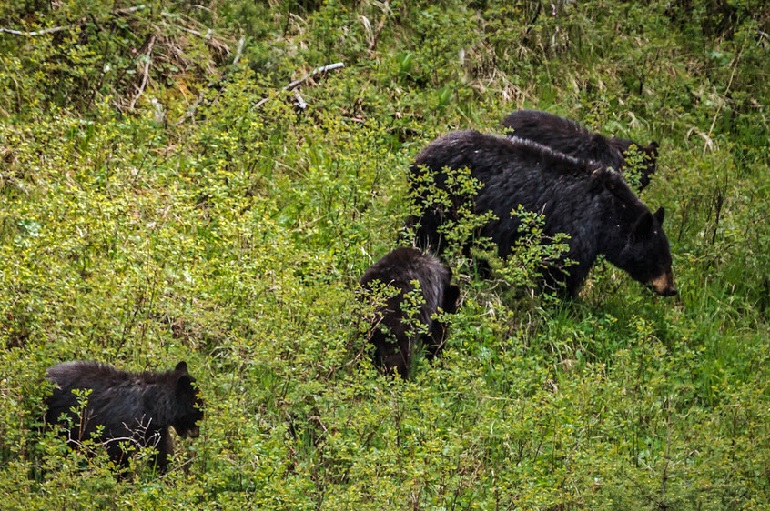
There was a time when black bears inhabited almost every section of forest from Alaska all the way down to Mexico, but a survey conducted in 1993 suggests that this is no longer the case.
Humans have taken up residence in areas where black bears once roamed, forcing them to abandon lands now used for agriculture and move into more scarcely populated forests.
Nevertheless, black bears still occupy much of their historical range, although they are less common in Southern Canada than they once were. The black bear population of Prince Edward Island died out completely in 1937, while those in the eastern states of the US appear to be thriving.
The Range and Habitat of America’s Black Bears
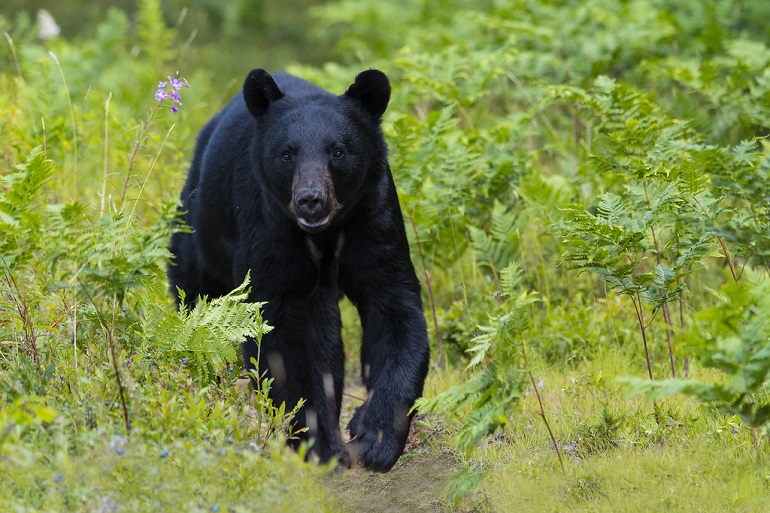
Black bears appear to avoid open areas, probably because they don’t want to compete with their larger cousins, the grizzly bears. Instead, black bears tend to stick to forests, woodlands, and other areas with thick vegetation.
These habitats provide them with plenty of food and offer some protection against potential predators like mountain lions.
Some black bears have gotten used to having human neighbors and have adapted to life on the edge of urban areas, even though this proximity often gets them into trouble.
As black bears are highly adaptable, their habitats are widely variable. In Mexico, the black bears mainly live in heavily vegetated areas high up in the mountains, while in Florida, they make do with swampy hardwood habitats.
A Detailed Description of the Black Bear
Here is a complete overview of the black bear’s physical description.
Build
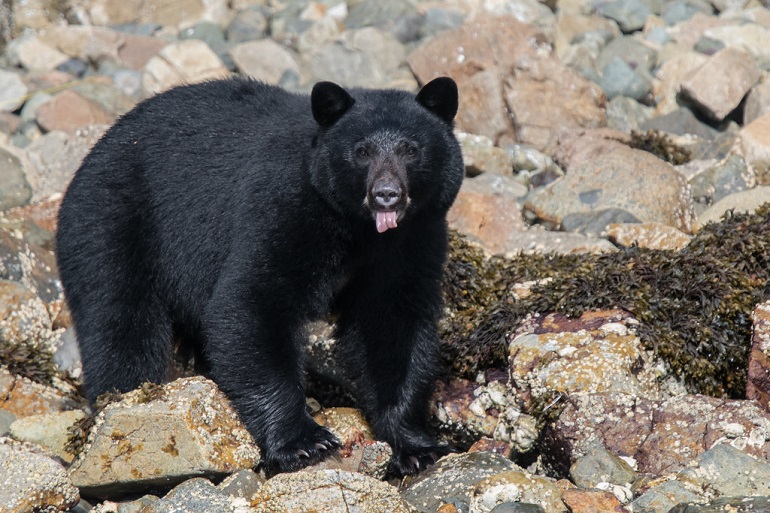
Black bears have broad heads and small, rounded ears, much like my favorite teddy bear! Fortunately, they have much stronger jaws than the average teddy bear and more dexterous paws.
The black bear’s paws are relatively large in proportion to its body, although they’re still much smaller than those of the polar bear. They have shorter claws than grizzly bears because they use them more for climbing than ripping apart their prey.
Black bears also lack the shoulder hump of the grizzly because they don’t need that additional strength for digging.
Size
Compared to other bears, black bears are quite small, but when you come face to face with one, you soon realize that size is relative, just like time! Black bears usually stand between 28 and 41 inches at the shoulder, which isn’t that much smaller than the grizzly.
Black Bear Weight
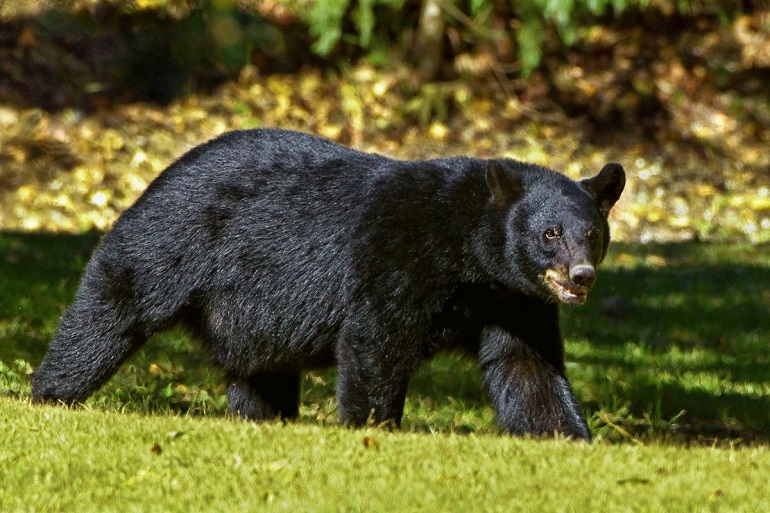
When it comes to weight, however, the black bear seems a lot smaller than the grizzly bear, especially when it emerges from its winter hibernation.
Black bears can lose up to 30% of their body weight over winter, so a bear that weighs 350 lbs at the end of summer could weigh just 245 lbs when it emerges from its den the following spring.
Pelage or Fur
It’s fair to assume that all black bears are black, but that isn’t the case. They all have thick fur coats, but the color varies from almost pure white to jet black, depending on where it lives and what time of year it is.
Over summer, the sun gradually bleaches the bear’s black fur, which is great for the bear, as it means it can forage in the hot summer sun without suffering from heat stroke.
Despite these seasonal variations, the different colors seen in black bears appear to be largely regional, as the table below indicates:
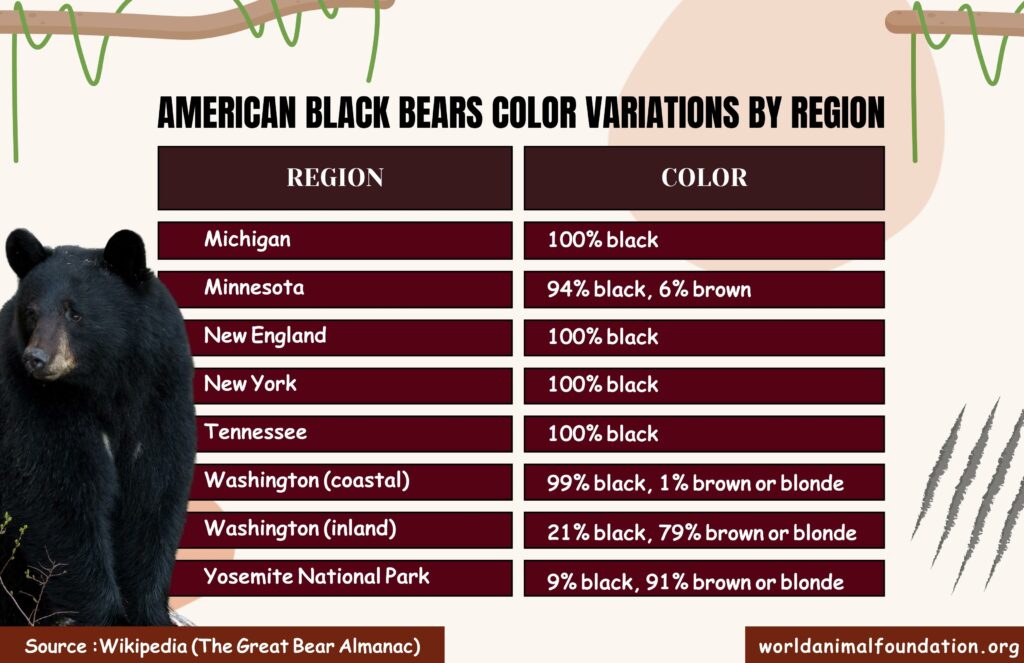
The Life History and Behavior of the Black Bear
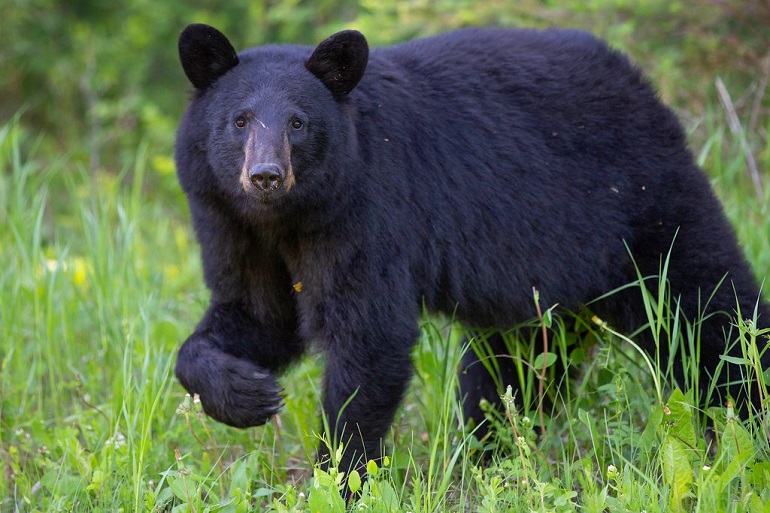
Despite having very small eyes, black bears can see just as well as humans, while their sense of hearing is twice as sensitive as ours. More important than either of those is the sense of smell, which black bears rely on to locate food sources.
They are also surprisingly athletic, capable of climbing trees and swimming long distances. They can also run faster than you might expect, especially in their lean months when they have less fat to slow them down.
Reproduction and Development
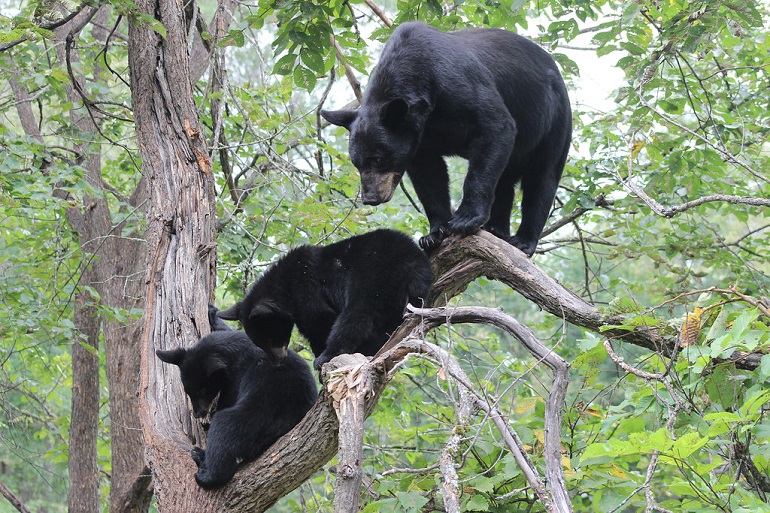
Female black bears reach sexual maturity when they’re three to four years old and produce their first litter of cubs shortly afterward, although not that shortly, as the gestation period lasts for an impressive 235 days – the equivalent of nearly eight months.
Black Bear Cubs
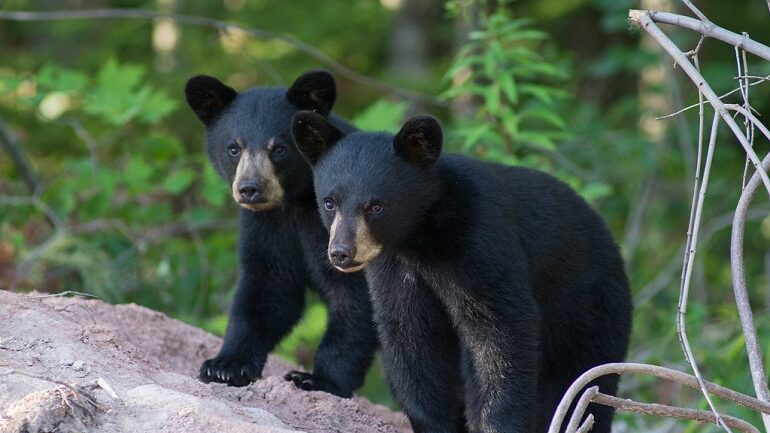
Litters can contain up to six cubs, but generally, females give birth to just three or four, each of which weighs less than a pound.
Black bear cubs only open their eyes for the first time when they’re around a month old and take their first steps when they reach five weeks.
The female bear nurses them until they’re between six and eight months, at which stage they’re ready for solid foods. They stay with their mothers for up to a year and a half, only leaving her after a second winter hibernation.
Longevity and Mortality
It’s not easy being a black bear, and few survive beyond around 18 years of age. Studies suggest that those living in wilderness areas have a better chance of reaching old age than those inhabiting areas close to human settlements.
The oldest known black bear reached the great age of 39 years old before it died in Minnesota in 2013.
Hibernation
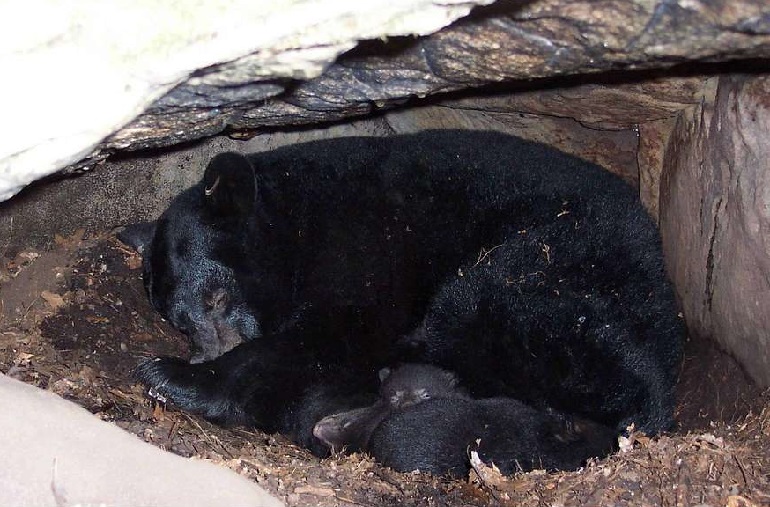
The idea of hibernating over winter sounds incredibly appealing, but not all black bears find it as tempting as they once did. Traditionally, black bears spend between three to eight months hibernating, but rising global temperatures are causing this to decline by several days a year.
In areas where the winter temperatures remain moderate, like Florida and Mexico, many black bears are choosing to skip their winter slumber and remain active all year.
What Do Black Bears Eat?
Black bears change their diets seasonally, partly in response to food availability and partly to compensate for their periods of inactivity. When black bears emerge from their dens at the end of winter, they’ll scavenge off dead carcasses before switching to a more vegetarian diet when the first spring shoots and buds appear.
During the summer, their diet consists mainly of berries, fruits, and insects, although no black bear can resist the taste of wild honey!
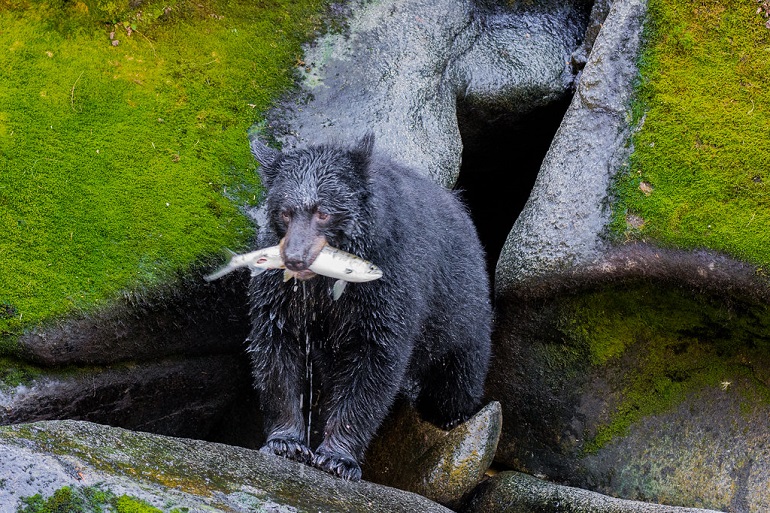
Bears that live close enough to the Pacific Coast hunt for salmon but do this under the cover of darkness when their black coats provide better camouflage. Only the Kermode bear can successfully hunt salmon during the day due to its lighter coat.
Black bears will prey on deer fawns during spring when they’re too small to outmaneuver the bear, and there have been occasions when black bears have taken down adult deer and even elk.
Black bears living close to human settlements sometimes develop bad eating habits, like Hank the Tank, who rummages for human leftovers in South Lake Tahoe, and now weighs nearly 500 lbs!
Interspecific Predatory Relationships
Black bears rely on their size and intimidating appearance to overpower their rivals, but they can’t do that with the larger brown bears, so they tend to avoid them by foraging at night and staying in more forested areas.
They have no such qualms about cougars, however, and regularly steal carcasses from under their noses.
While grizzly bears will stand their ground against wolves, black bears aren’t so keen, possibly because they rarely come out on top.
The Black Bear and Its Relationship With Humans
Keep reading to get an insight into the black bear-human relationship.
In Folklore, Mythology, and Culture
The indigenous people of North America relied on the black bear for food, hides, and tools, but they also recognized them as culturally important, upholding them as “symbols of strength, hard work, and love.”
Bears also have a place in Korean culture, where they symbolize patience, and in Russia, where they’re seen as the mythical masters of the forest.
Attacks on Humans
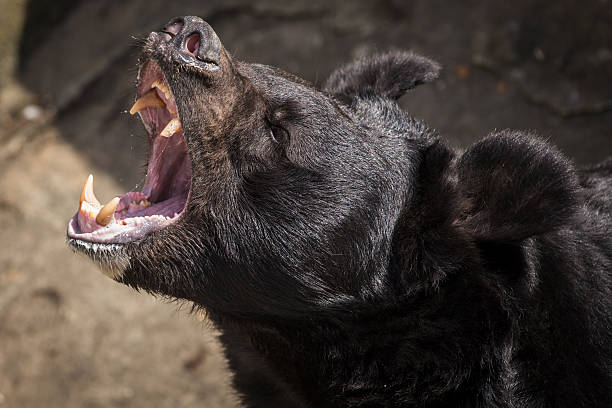
The black bear’s relationship with humans today is rather strained, even though they avoid confrontation whenever possible and rarely attack.
Nevertheless, incidents do happen and sometimes prove fatal. In 2021, a Colorado woman was killed in a suspected black bear attack, the fourth fatal attack in the state since 1960.
Black bears will attack if they feel threatened but rarely do. Curiously enough, most bear attacks occur in remote areas where they have little contact with humans, suggesting that the animals that rummage in your garbage cans are used to your presence, so feel less inclined to defend themselves.
Livestock and Crop Predation
Black bears only seem to resort to human food sources when there’s nothing else to eat or they’re trying to fatten themselves up to get ready for hibernation.
Unfortunately, when a black bear decides it’s going to help itself to a crop of oats, it often ends up doing extensive damage, bringing it into conflict with farmers.
Black bears will also opportunistically prey on livestock, especially smaller animals like goats and sheep. This usually occurs in the spring, when the bears emerge from hibernation and need a hearty meal.
Hunting
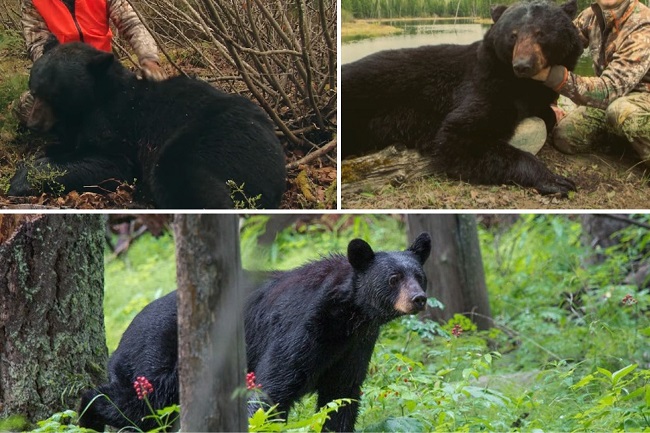
Although the indigenous people of North America hunted bears, they did so sustainably, unlike the European settlers who hunted, trapped, and poisoned bears, eliminating them from nearly half of their former range.
Although the black bear population has recovered to a large extent, the hunting continues, with around 40,000 to 50,000 being killed in Canada and North America every year.
Meat
People have been eating bear meat for as long as they’ve been hunting them, although most will only eat bear meat in spring when the animal’s been enjoying a vegetarian diet. This makes the meat more palatable and stops it from smelling like dead fish!
Bear meat is surprisingly tasty, with many saying it tastes a little like pork. It’s also better for your health than many other types of meat.
According to the USDA FoodData Central, the nutritional value of 100g of Alaskan bear meat is:
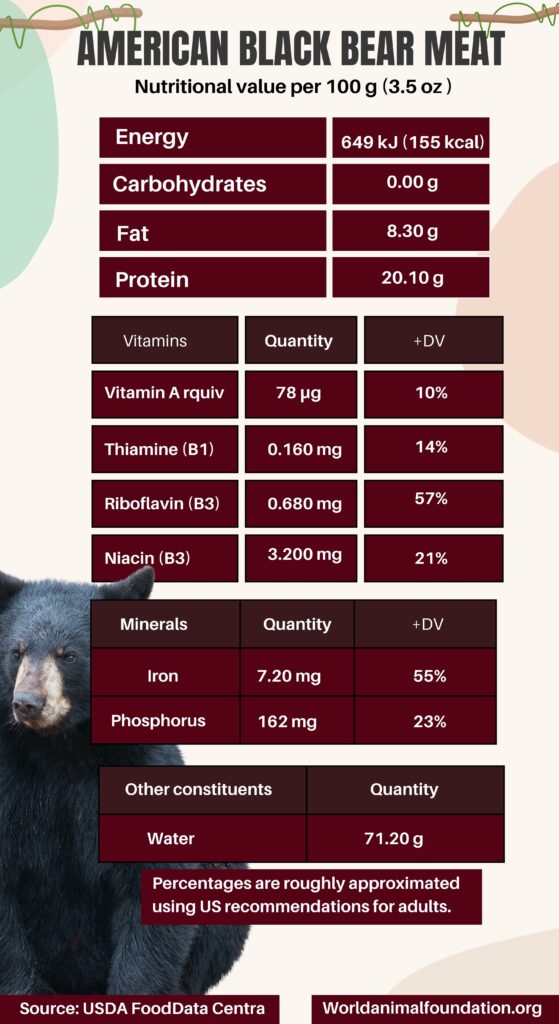
Black Bear Facts
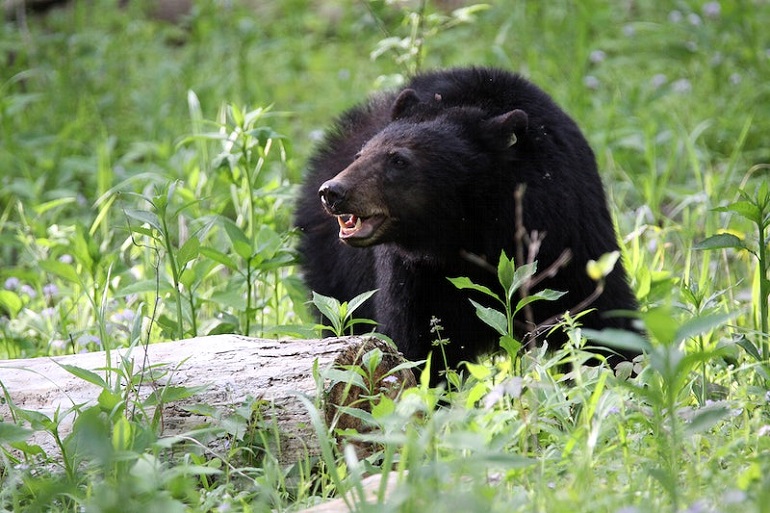
Here are some interesting black bear facts for you.
- Black bears are extremely strong and can knock over a 325-pound boulder with a single forepaw.
- The bite force of the black bear is similar to that of a domestic dog, at around 800 PSI.
- Black bears cover the ground at up to 30mph in spring, when they have less body weight to slow them down.
Threats to the Black Bear Population
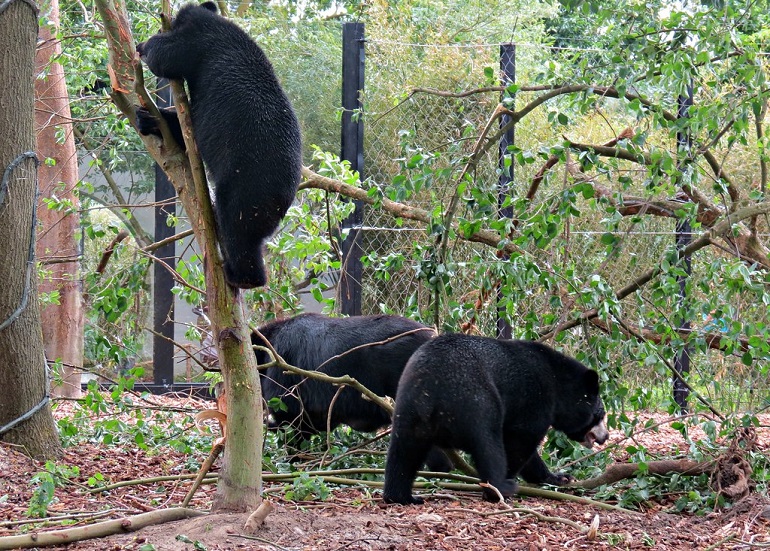
Black bear populations are considered relatively stable, with around 850,000 to 900,000 black bears currently living in North America.
They aren’t exempt from the threats of climate change and global warming, however, and scientists fear that if they stop hibernating, they could deplete their natural resources.
Other threats to black bears are largely manmade. Human development disrupts their natural habitat, while the increasing network of roads increases the chances of vehicle collisions.
Conservation Status of the Black Bear
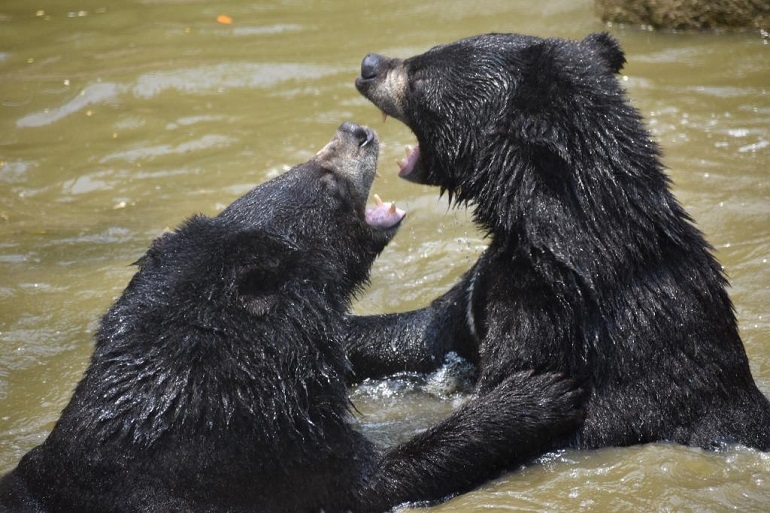
Enough American black bears are living in our forests that the IUCN considers them a species of Least Concern, even though some subspecies may be under threat.
Conservationists have petitioned for the Florida and Louisiana black bear subspecies to be considered for protection, but their populations are thought to be stable enough that they were removed from the Federal List of Endangered and Threatened Wildlife some years ago.
Black Bear Lifespan
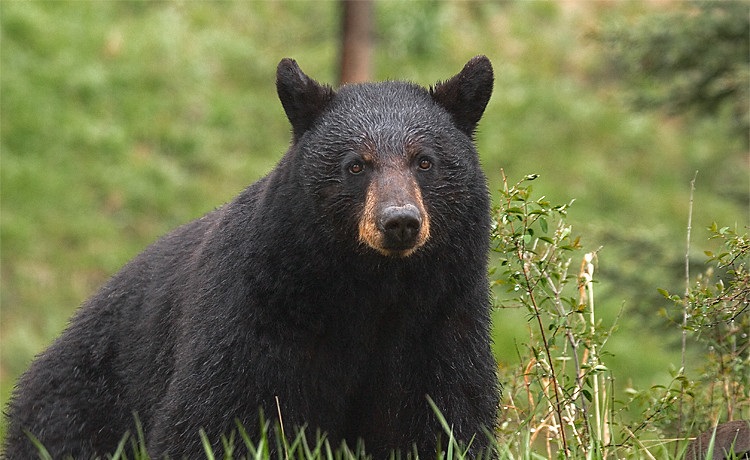
Black bears living in captivity often survive for up to 30 years, while the average life expectancy of those in the wild hovers around 10 to 15 years.
FAQ’s
How Big is a Black Bear?
From nose to tail, black bears usually measure between 4.3 and 6.2 feet long, making them roughly four or five times bigger than your average teddy bear!
They also weigh a lot more than that, with large amales reaching 902 pounds at their heaviest – more than three times the weight of your average giant panda bear!
Are Black Bears Nocturnal?
In their natural environment, black bears are more active during the day, unless they’re hunting for salmon, which requires a little more stealth!
In areas where black bears are liable to come into contact with other bears or humans, they change their behavior and forage more at night.
What State Has the Most Black Bears?
If you want to see an American black bear in the flesh (or the fur), the best place to go is California. With between 25,000 and 35,000 individuals, it’s got a bigger black bear population than any other state. Yet another reason to visit the Golden State!
Are North American Black Bears Herbivores, Carnivores, or Omnivores?
Black bears have widely varied diets that include everything from elk carcasses to insects, berries to fish, which makes them omnivorous.
What Kingdom Do North American Black Bears Belong To?
Black bears belong to the animal kingdom, as do all other types of bears, except the stuffed toy variety!
Conclusion
Thank you for bearing with me to the very end, and I hope this article about black bears has given you paws for thought!
Black bears aren’t the aggressive monsters they’re sometimes made out to be, but rather timid, shy creatures that climb trees rather than stand their ground.
That’s not to say they won’t defend themselves if caught raiding your garbage can or fridge, but if you keep your leftover pizzas safely locked away, you shouldn’t have to worry anymore about the black bear than you do your daughter’s teddy!


